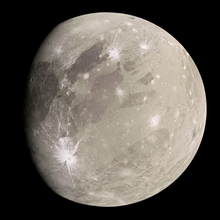This articleneeds additional citations forverification.(May 2014) |
Anice planetoricy planetis a type ofplanetwith an icy surface ofvolatilessuch aswater,ammonia,andmethane.Ice planets consist of a globalcryosphere.

Under ageophysical definition of planet,the small icy worlds of theSolar Systemqualify as icy planets. These include most of theplanetary-mass moons,such asGanymede,Titan,Europa,Enceladus,andTriton;and also most of the knowndwarf planets,such asPluto,Orcus,Haumea,Makemake,Quaoar,Sedna,Gonggong,andEris.In June 2020,NASA scientistsreported that it is likely thatexoplanetswith oceans, including some with oceans that may lie beneath a layer of surface ice, may becommonin theMilky Way galaxy,based onmathematical modeling studies.Gliese 667 C d,orbiting the trinary starGliese 667,is a possible example of ice planet.[1][2]
Characteristics and habitability
editAn ice planet's surface can be composed ofwater,methane,ammonia,carbon dioxide(known as "dry ice"),carbon monoxide,nitrogen,and other volatiles, depending on its surface temperature. Ice planets would have surface temperatures below 260K(−13 °C) if composed primarily ofwater,below 180 K (−93 °C) if primarily composed of CO2andammonia,and below 80 K (−193 °C) if composed primarily of methane.
On the surface, ice planets are hostile to life forms like those living on Earth because they are extremely cold. Many ice worlds likely havesubsurface oceans,warmed byinternal heatortidal forcesfrom another nearby body. Liquid subsurface water would provide habitable conditions forlife,includingfish,plankton,andmicroorganisms.Subsurface plants as we know them could not exist because there is no sunlight to use forphotosynthesis.Microorganisms can produce nutrients using specific chemicals (chemosynthesis) that may provide food and energy for other organisms. Some planets, if conditions are right, may have significant atmospheres and surface liquids like Saturn's moonTitan,which could be habitable forexotic forms of life.
Objects and possible examples
editAlthough there are many icy objects in theSolar System,none of them qualify as planets under theIAU definition of planet.However, mostplanetary-mass moonsare ice-rock (e.g.Ganymede,Callisto,Enceladus,Titan,andTriton) or even primarily ice (e.g.Mimas,Tethys,Dione,Rhea,andIapetus) and so qualify as ice planets undergeophysical definitionsof the term. The largestKuiper beltobjects, such asPluto,Haumea,Makemake,Charon,Quaoar,andOrcus[3]also qualify as such under geophysical definitions.Europais also often considered an ice planet due to its surface ice, though its high density indicates that its interior is mostly rocky. The same is true for the scattered-disc objectsSedna,GonggongandEris.[4]
Ten known exoplanets are likely ice planets, given their compositions, orbits, densities, and host stars. Possible examples of ice planets includeOGLE-2005-BLG-390Lb,OGLE-2013-BLG-0341LBb,Gliese 667 C d,Kepler-441b,OGLE-2016-BLG-1195LbandMOA-2007-BLG-192Lb.
See also
edit- Ice giant
- Icy moon
- Ocean world
- Snowball Earth
- Hoth– Fictional planet in Star Wars
References
edit- ^NASA(18 June 2020)."Are planets with oceans common in the galaxy? It's likely, NASA scientists find".EurekAlert!.Retrieved20 June2020.
- ^Shekhtman, Lonnie; et al. (18 June 2020)."Are Planets with Oceans Common in the Galaxy? It's Likely, NASA Scientists Find".NASA.Retrieved20 June2020.
- ^Stern, Alan;Mitton, Jacqueline(2005)."Pluto and Charon: ice worlds on the ragged edge of the solar system".Weinheim:Wiley-VCH.RetrievedJuly 13,2013.
- ^Emily Lakdawalla et al.,What Is A Planet?The Planetary Society, 21 April 2020